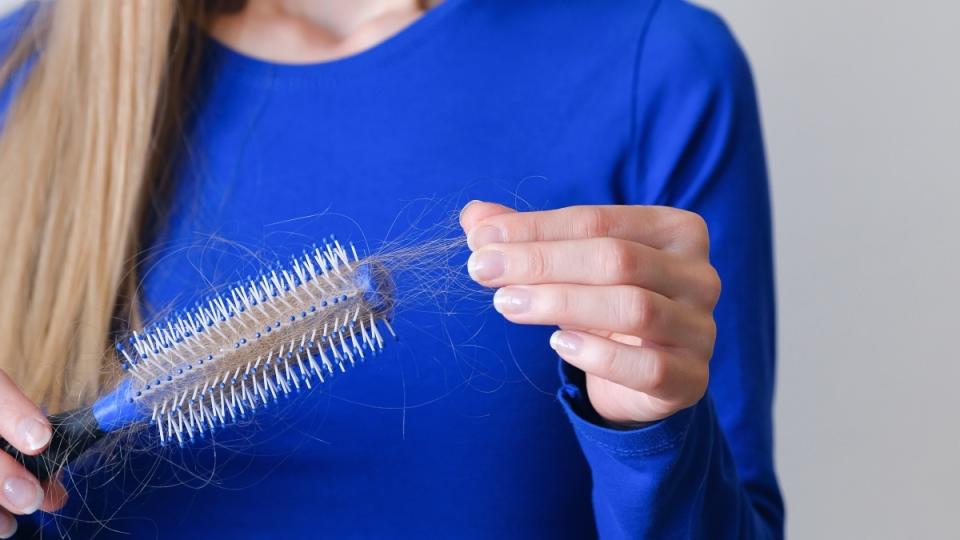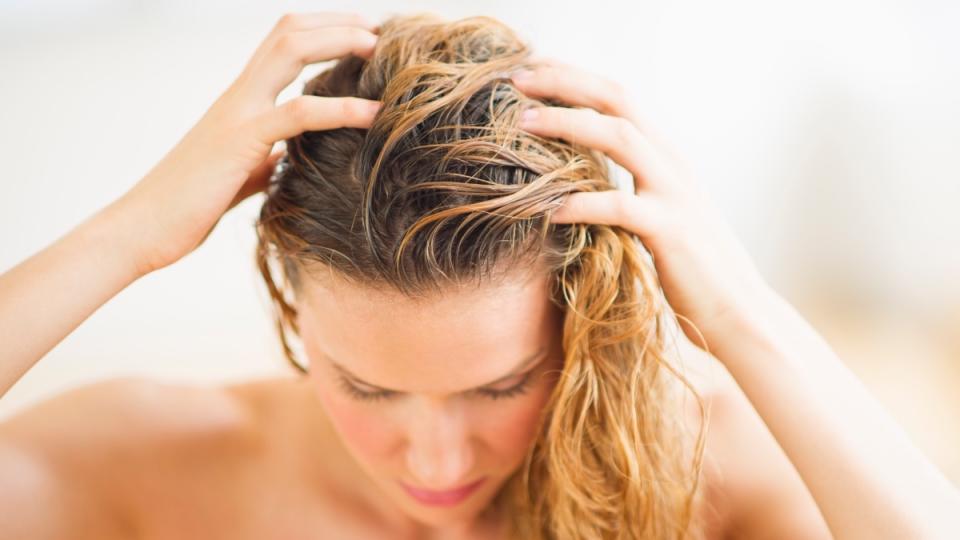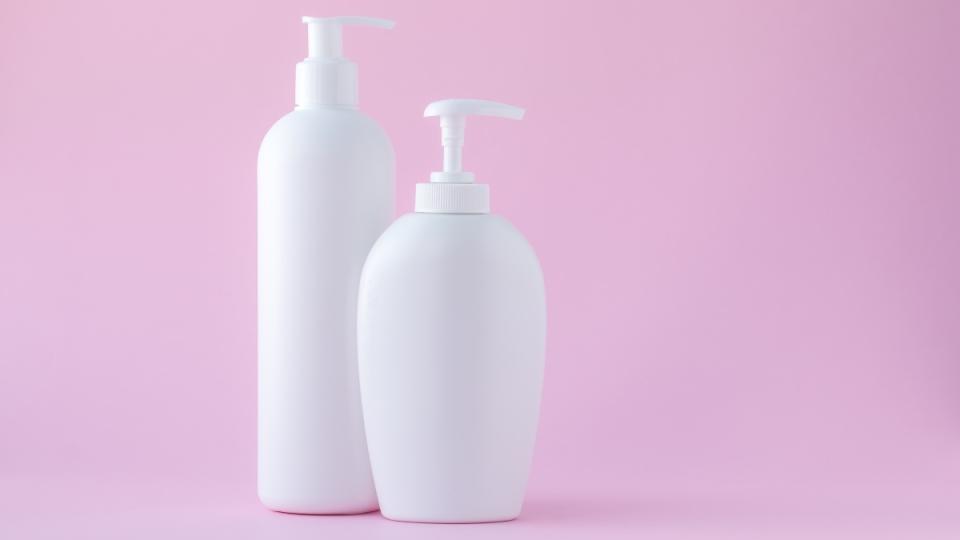Noticed more strands in your hair brush or shower drain lately? Or maybe you’ve spotted sparse spots on your scalp. Unfortunately, many of us experience at least some degree of hair loss as the we age. But on the bright side, there are treatments that can help reduce loss and spur growth, and one the most promising is spironolactone for hair loss.
Spironolactone is a type of diuretic that is traditionally used to help reduce high blood pressure. But it turns out the prescription med also can help reverse hair thinning. We spoke to dermatologists and researchers to get all the tips on how spironolactone works and why it may be a smart choice for those experiencing hair loss.
What causes hair loss in women?
Up to 40% of women will have noticeable hair loss by age 50. One of the most common culprits? Age. “For most people, the hair does thin with age,” says Sonya Kenkare, MD, FAAD, a board-certified dermatologist at the Illinois Dermatology Institute. “The hair loss continues through life for most people — the density just decreases over time.”
Many women dealing with hair loss have what’s known as androgenetic alopecia, or female pattern baldness. The conditions affects up to 30 million women in the U.S., usually those age 40 and older.
“This type of hair loss is caused by excess androgens or an excess response or sensitivity to androgens [male sex hormones] that is more common with age,” explains Lauren Ploch, MD, FAAD, a board-certified dermatologist at Georgia Dermatology and Skin Cancer Center. “Androgens target the hair follicle and cause hair loss in both women and men. Androgens can also cause hair to grow in places that most women do not want hair, such as the chin and lower face.”
Like male pattern baldness, androgenetic alopecia in women is also hereditary, although it usually presents differently. “In men, the hairline starts receding,” says. Dr. Kenkare. “But a lot of times in women, the frontal hairline is maintained, but the crown of the scalp gets really thin.”

Other causes of hair loss in women
Another less common cause of hair loss is a type of alopecia called telogen effluvium, which can be brought on by stressful events or medication changes. “Because we are more likely to have medication changes or medical events as we age, this becomes more common over time,” Dr. Ploch says.
Other reasons may lose hair include:
-
An iron deficiency
-
A vitamin D deficiency
-
Stress, anxiety or depression
-
Thyroid disease
-
Severe infection or high fever
-
Eating too little protein or calories
The good news is that whatever’s behind your hair loss, a medication known as spironolactone might be able to help.
How spironolactone for hair loss works
While the “water pill” is typically used to treat high blood pressure, spironolactone can also help manage liver disease and kidney disease. The medication acts an aldosterone receptor antagonist, meaning it blocks the effect of androgens on the hair follicles. “The mechanism of action is thought to be that it reduces some of the testosterones that contribute to androgenetic alopecia, so it can slow its progression,” Dr. Kenkare explains.
Spironolactone for hair loss is by prescription only
To tap into the benefits of spironolactone for hair loss, you’ll need to visit your doctor for a prescription. “Spironolactone is available as a generic medication, and it is usually covered by insurance,” Dr. Kenkare says. “The most important thing is to be evaluated by a board-certified dermatologist to see what all of your options are and what will give you the most benefit.”
Spironolactone is taken in pill form, and daily dosages usually range from 25 to 200 mg. It’s important to note that the medication can sometimes cause side effects such as:
-
Drowsiness
-
Restlessness
-
Vomiting
-
Diarrhea
-
Enlarged or painful breasts
-
Vaginal bleeding in post-menopausal women
-
Hair growth on other parts of the body
-
Deepening of the voice
-
Stomach pain or cramps


What research says about spironolactone for hair loss
“Spironolactone is a great medication,” Dr. Ploch says. “Not only does it help with hair loss, but it helps treat hormonal acne and excessive facial hair growth in women, too.” It’s effective for androgenetic alopecia hair loss in women, both used on its own and in tandem with other treatments.
In fact, UCLA researchers studying spironolactone for female pattern hair loss found that the medication was highly effective in promoting hair growth and stopping loss. “Our research showed that approximately 3/4 of women who took spironolactone for their hair loss either had improved hair growth or stabilized,” says Carolyn Goh, MD, dermatologist at UCLA Health and one of the authors of the study. “We also found that patients with acne or hirsutism [facial hair growth] had a better response to spironolactone.”
Other studies have shown that combination therapy using spironolactone and oral minoxidil for hair loss has been successful. And Dr. Kenkare says she has seen positive results from spironolactone prescribed alongside other treatments.
“I think it’s very helpful for patients in the context of using it as part of a multi-prong approach,” she says. “I’ll use it with Minoxidil, ketoconazole shampoo and some kind of multivitamin such as Nutrafol or a prenatal vitamin to stimulate hair regrowth.” (more on those below)
Worth noting: Spironolactone for hair loss usually doesn’t work immediately and can sometimes take up to six months to trigger new growth.
Ways to boost hair growth for women
If you’re looking to speed results of spironolactone for hair loss, there are other treatments that can be effective in slowing loss and improving regrowth. Here’s what our experts say can help:
1. Massage on minoxidil
Minoxidil is another common treatment for hair loss. The over-the-counter remedy comes in foam or solution formulas that you apply directly onto the scalp. It works by affecting potassium channels in hair follicles, stimulating microcirculation around the follicles. “Minoxidil is one of the heaviest lifters in the hair loss world,” Dr. Kenkare says. “Especially so when it’s part of a multi-prong treatment approach.”


Related: 11 Best Hair Growth Products for Women Over 50 to Treat Thinning, According to Hair Loss Experts
2. Take a multivitamin
Deficiencies in iron and vitamin D can cause or exacerbate androgenetic alopecia and telogen effluvium. And for those who don’t get enough of these nutrients from their diets, a multivitamin can help fill in those gaps. Multivitamins also usually contain other vitamins and minerals that improve hair and scalp health, including vitamins C and E.
“Low vitamin D, low iron or anemia — all of these things can contribute to worsening of androgenic alopecia or create their own types of nutritional forms of hair loss,” Dr Kenkare says.
One thing to make sure your multi doesn’t have? Biotin, a water-soluble B vitamin that some folks claim improves hair health. But Dr. Kenkare cautions that biotin supplements can actually cause more harm than good sometimes.
“An overall multivitamin is actually more helpful than doing something that’s just high biotin,” she explains. “Biotin can result in some inaccuracies in lab tests in the emergency room. So we recommend those with a great deal of caution.”
3. Use ketoconazole shampoo
Ketoconazole shampoo works as anti-fungal and doctors typically recommend it to treat dandruff or other scalp conditions. But research suggests the medicated shampoo may also help slow hair loss even if you don’t have dandruff. That’s because ketoconazole has anti-androgenic properties that work against the sex hormones that cause androgenetic alopecia.
In addition, Dr. Kenkare recommends gentle hair care to prevent or slow hair loss. “Gentle haircare is super important for hair maintenance,” she says. “Minimizing chemical treatment, bleaching of hair and keeping heat treatment to a minimum is really helpful for hair.” (Discover how treating an itchy scalp can reverse hair loss.)


4. Consider low-level light therapy
Dr. Kenkare says that some patients with androgenetic alopecia use low-level light therapy to help stimulate the hair follicle. Sometimes called red light therapy or low-level laser therapy, the treatment stimulates cellular activity in tissues, promoting tissue repair and regeneration. You can buy light therapy caps online, but our experts advise seeing a specialist who can conduct the treatment safely and maximize the results.
For more ways to outsmart hair loss and sparse strands:
Ozempic Can Be a Sneaky Cause of Hair Loss — Dermatologists Reveal How to Restore Volume
Hair Experts’ Top 5 Tips for a Healthy Scalp to Help Reverse Hair Loss, Dandruff and More
Itchy Scalp and Hair Loss? Dermatologists Reveal the Surprising Cause + How to Speed Regrowth
Source Agencies


